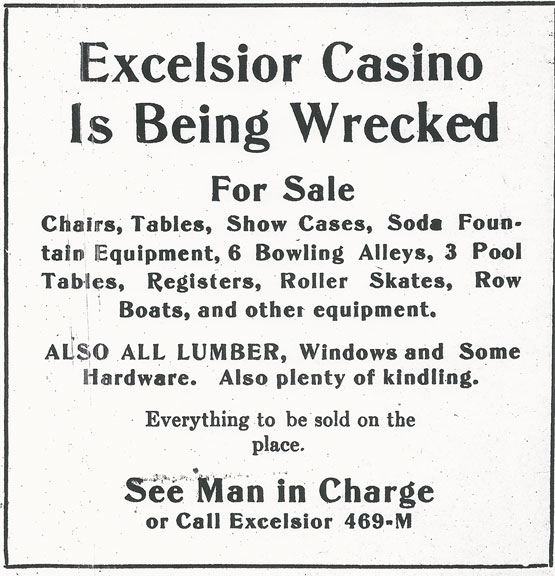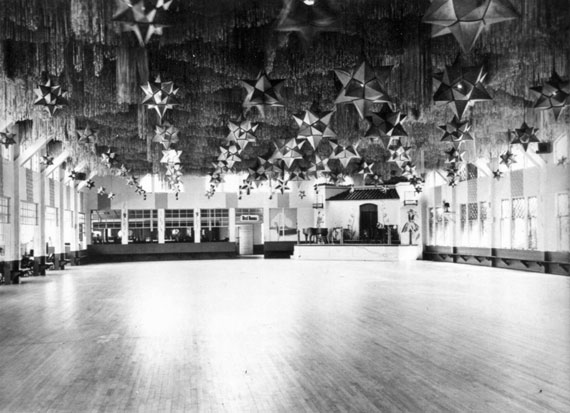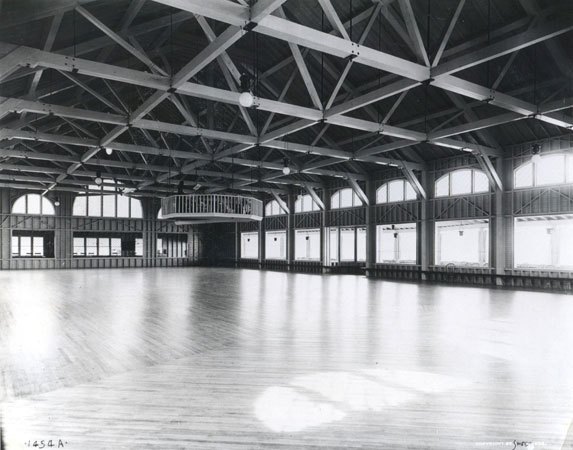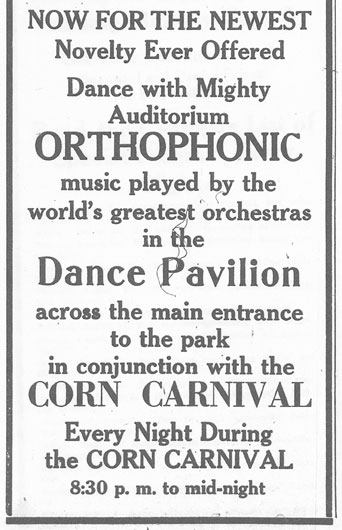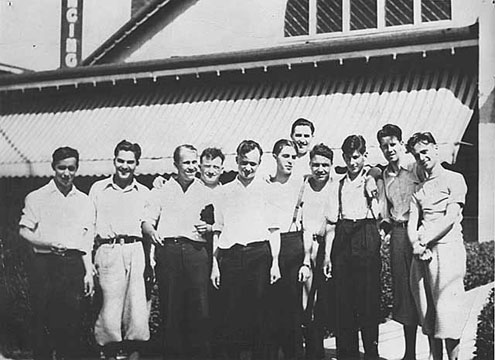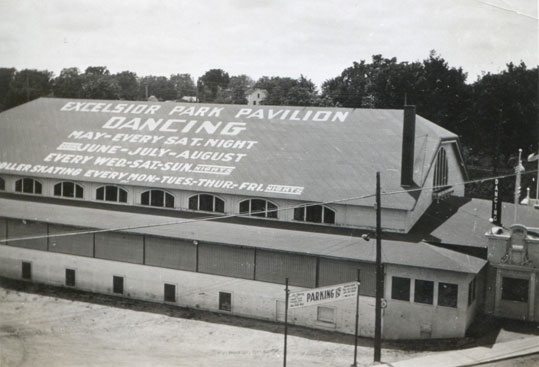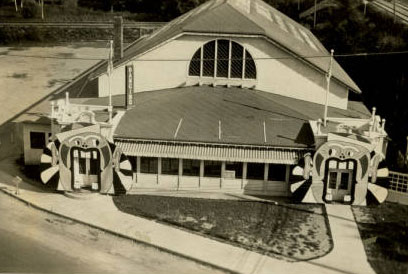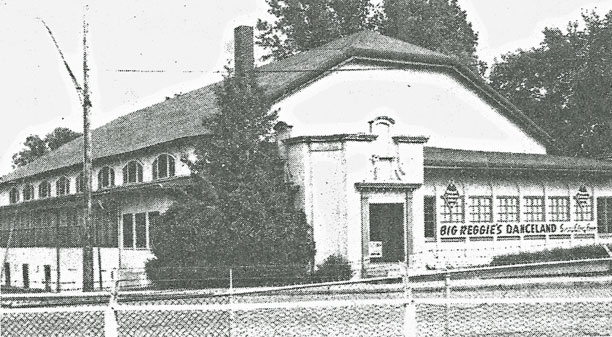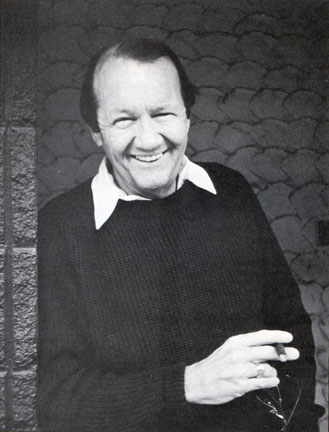 |
|
Excelsior Amusement Park, the site of many a school picnic and provider of Free Rides for Good Grades, opened on May 30, 1925. The park was owned by the streetcar company, opened to create ridership on the line. Fred W. Pearce, Sr., of Detroit was brought in to run it. Pearce soon purchased the park. Myths abound about the park and the pavilion.
TONKA BAY PAVILION
Most of the following information came from articles in the Minnetonka Record newspaper.
Was Danceland
The more I read this the more confused I get.
On January 23, 1920: Horace Lowry, president of the Twin City Lines (streetcar), offered the Tonka Bay roller skating pavilion as a gift to the Excelsior park board for use on the Excelsior commons. Bonds would have to be voted on to raise funds to move the building from Tonka Bay to Excelsior. "It would serve as a center for housing summer concerts and entertainments and would afford shelter to picnic crowds in case of sudden storm."
On May 8, 1920, there was an ad for the first dance of the season at the Casino in Excelsior. Music by Squires' Orchestra; tickets were $1 per Couple. Extra Lady 25 cents. The Casino pavillion was doing a thriving weekend business as well as Saturday night hops (May 28, 1920).
On October 13, 1922: Eber Armagost and J.E. McNiece of Excelsior had purchased the Tonka Bay Casino and were having it razed. "The lumber will be used to build a new casino at the street railway dock station in Excelsior. It will be 100x150 feet and will be completed by spring. J.E. Weinholz has the contract." Armagost worked for the trolley company.
On December 1, 1922: The Excelsior Park Board had purchased the ground upon which the Casino stands. "By this action the park again comes into possession of the shore which was laid aside for it by the original settlers. In 1903 the village vacated the land. The Park Board bought it from its present owner, R. Golden, for $6,000. The Casino lease expires January 1, 1923, and the building is to be removed by March 1. The Park Board plans to beautify the shore and maintain it for the use of the public."
On December 15, 1922: "The Excelsior Casino, which was built in 1902, will soon be no more. A wrecking crew started work on it this week and the building will be razed to the ground. The work is in charge of Elmer Carlson and Oskar Carlson." The ad below is dated December 22, 1922.
Legend has it that the porches were removed and the building was towed across the frozen Lake Minnetonka from Tonka Bay to Excelsior. It seems that if that had happened it would have certainly been sensational enough to be in the newspaper, but I found no such report. Further confusing the matter is an article from July 1953:
LAKE VIEW PARK PAVILION
May 4, 1923:
Lake View Park dancing pavilion had its Grand Opening on Friday, May 25, 1923, with souvenirs and novelties for all. There was dancing every Wednesday and Saturday; Gents got in for 55 cents, Ladies for 30 cents. Music was provided by the Clarence Peterson Lake View Park Orchestra.
Photos above and below courtesy Excelsior-Lake Minnetonka Historical Society
July 6, 1923: Meanwhile, Captain J.R. Johnson was dredging Excelsior Bay, "deepening the water and improving the shore from the sail boat dock almost to the express boat docks. The biggest portion of this work was deepening the water in front of the old casino site and filling in the depression when the casino was razed.... A small mountain of black mud has been thrown up where the casino stood. It is being graded down by the Park Board and will be seeded. A fine green park will be made, extending to the water's edge, at the foot of Water Street. When completed, it will be a miniature Batteray (sic)."
Lake View Park Pavilion introduced dances on Sundays in July 1923. This caused consternation among the members of the Women's Club, supported by "the church people." "The question is being discussed as a moral problem People are debating whether Excelsior should abandon its time honored custom and be the first village in the lake region to permit the operation of public dance halls on Sunday." The question was left up to a public referendum that was held on Saturday, July 21, 1923. Despite a big "Vote NO!" ad in the Record, the tally was 252 for Sunday dancing and 205 against.
A "monster dance" was held on Hallowe'en 1923 at Lake View Park Pavilion. Tickets were sold for two months prior, with the prize of a five passenger Star touring car promised as the prize. The party was a great success, and the car was won by Miss Hazel Holman, who worked for the George H. Hasher Grocery Store.
October 26, 1923: Lake View Pavilion to Have Heating Plant. Two hot air furnaces were installed for Saturday dances. Basketball games were also held in the pavilion.
April 26 was the start of the 1924 dancing season, with Saturday night dances until the regular summer season began in June. Music was again provided by Clarence Peterson's Lake View Orchestra (eight pieces).
On March 27, 1925, the Excelsior Athletic Association put on a show that included:
September 11, 1925: Although the end of the Lake season was at hand, "The Lake View Pavilion, which has become the most popular dance pavilion around the lake, will continue to have dances three nights during the week, Wednesday, Saturday and Sunday."
EXCELSIOR PARK PAVILION
March 25, 1927: McNiece Revives Roller Skating: J.E. McNiece, proprietor of the Excelsior Park Pavilion, will open the pavilion Sunday night for roller skating and will continue three nights a week through the spring and summer months. During the summer, skating will be alternated with dances three nights a week. There will be music for the skaters as well as for the dances." Does the name change indicate change of ownership? McNiece is still the "proprietor."
April 1, 1927: "J.E. McNiece will open the dancing season at the Excelsior Park Pavilion on April 16 [with an Apple Blossom Dance]. Special music for the opening night has been engaged.... Mr. McNiece's dances have always been clean and orderly and he says the same high standard will be maintained through the coming season."
April 8, 1927, and more confusion: The Excelsior Park Board was sued by creditors Lyman Lumber Co. and J.C. Winholz for materials and services used in building the pavilion on the commons several years ago. Is that the dance pavilion?
The summer of 1927 at the Excelsior Park Pavilion had a heavy schedule: Dances every Wednesday, Saturday, and Sunday nights, and roller skating ever Monday, Tuesday, Thursday, and Friday nights. Wait - it says Skating Wednesday, Saturday, Sunday, Excelsior Commons Pavilion. Different Place!
On August 13 and 14, 1927, the Excelsior Park Pavilion hosted special dances with Hal Keller's 8-piece Band, just back from a nine month tour. Keller was formerly with Isham Jones' Orchestra in Chicago. New prices: Ladies 25c, Gents 50c.
A Gala Corn Carnival was held at the Park from August 21 to September 5. Something called the Auditorium Orthophonic was installed in the Dance Pavilion; this appears to be an amplified record player.
By the end of August 1927, dances were only on Saturday nights, and roller skating every night but Saturday. The October 1st Saturday dance was called the Kiss Dance, with music by the Original Royal Vagabonds - Eight Master Players, Singers, Entertainers. Ladies and Gents both 50 cents.
What's this? In an ad for a basketball game between the Williams Brothers of St. Louis Park (Yea!) and Excelsior on January 18, 1928, the paper called the venue the Lake View Pavilion. There's a missing issue of the Record, and then on January 27, 1928, it's back to the Excelsior Pavilion. Another game between the Excelsior Firemen and the Minneapolis Business College on February 25, 1928, was described as being at the Excelsior Park Pavilion.
EXCELSIOR GARDEN PAVILION
April 17, 1928: Excelsior Garden Pavilion. Dancing Every Saturday Night. Something New and Different. Come dance in the garden on the green. Change of orchestra every week. Eddie Corlew and his Aristocrats, formerly at the Merigold (sic), will furnish the music Saturday night, April 28th. Ladies 25c, Gents 50c.
May 11, 1928:
EXCELSIOR DANCE PAVILION
Having a tree in the middle of a dance floor might not have worked. Sometime between May and November, 1928, the property changed hands and the ad for the Grand Opening of the Winter Schedule at the Excelsior Dance Pavilion cited the Fred W. Pearce Corp. as owners of the Excelsior Amusement Park and Dance Pavilion. Music for the November 17 dance was provided by Wesley Barlow's Hotel Nicollet Orchestra (Ten Pieces).
From 1930 until his death in 1956 the manager was Rudy Shogran, who is described as a "master of the promo." One of his stunts was to provide motorcycle escorts to bring national acts performing downtown at the Orpheum out after their shows. Dance bands that performed at the hall in the 1930s through the 1950s included:
Above photo courtesy Excelsior-Lake Minnetonka Historical Society
In 1940 the park began to sponsor a Twin City High School Fun Night, featuring a dance band in the ballroom and free rides. Thousands of kids would converge on the park, with special transportation arranged.
MISS MINNESOTA
From at least 1950 to 1957 Excelsior Park was the site of the Miss Minnesota contest.
The tenth annual Miss Minnesota contest was held at the Park on August 13, 1950. Cedric Adams of WCCO was the emcee of the bathing suit competition, and Jack Thayer of WLOL was the emcee of the evening gown and talent competitions. Music was provided by Bud Strawn's Orchestra, the park's house band.
In 1952 Excelsior Park hosted the 12th annual Miss Minnesota-Universe Pageant, directed by Rudy Shogran. Cedric Adams of WCCO radio was the emcee of the bathing suit competition, and Jack Thayer of WLOL emceed the evening gown and talent competitions. Music was provided by Les Williams and His Orchestra.
The Miss Minnesota-Universe Pageant took place at the Park on June 16, 1957, directed by Ray Colihan. Jack Thayer of WDGY was the emcee and music was provided by singer Gloria Greer, the Joe Kimble Trio, and the Showoffs.
Ray Colihan, aka "Big Reggie” (see below) became the manager of Danceland in 1956 and soon the music gave way to rock 'n' roll.
Photos above and below courtesy Excelsior-Lake Minnetonka Historical Society
This photo is not so good but it has the Big Reggie's sign on it.
THE BEACH BOYS AT DANCELAND
Every spring, the amusement park sponsored a Twin City High School Night for the area's teens. In February 1963, Colihan booked the Beach Boys to perform for that year's show and dance, reported for only $400. At the time they were booked, the group had charted four records on the Billboard charts, notably "Surfin' Safari," which entered the chart in August 1962 and reached #14, but they hadn't had any top 10 hits. Then, on March 23, 1963, "Surfin' USA" entered the chart, a monster hit eventually reaching #3. So by May 3, 1963, they were big, and Colihan had scored a real coup.
The Minnetonka Record predicted:
The problem was that thousands and thousands of kids DID show up, and Colihan was afraid they would tear down the roller coaster. As it was they were tearing out the screens and crawling in the windows. Police and firemen were called in to control the chaos.
From www.lakeminnetonka.com:
One local legend is that the Boys' bass player (who at that time would have been Al Jardine) had somehow forgotten his bass, and Colihan played bass, so he rented his instrument to them for the show. Believe it - or not.
Another potential coup was booking the ROLLING STONES in 1964, but that didn't turn out quite so well - see that story HERE.
Danceland was a mecca for local “stomp” bands like the Trashmen and the Underbeats. In fact, kids stomped a 10 ft. depression in the dance floor at one Underbeats gig, according to an interview at www.minniepaulmusic.com - the girls screamed, the inspector inspected, and the dance continued. Tony Andreason of the Trashmen said, "When you went to a place like Danceland, there was electricity in the air before the band went on. Once things kicked off, bands would feed off the intensity in the room and [off of] the dancers' requests."
Other acts that appeared at Danceland included:
THE DANCELAND GANG WAR OF 1966
In the '60s, Danceland's popularity led to clashes between kids who had been drinking or were in gangs. The house gang was the X-Boys, who defended their territory against alien gangs like the Suprees, the Baldies and the Animals. Supposedly there were 13 X-Boys, and they wore green and white letterman-like jackets. Although the dance hall sold no alcohol, it flowed outside, and fights were common.
Saturday night, April 16, 1966, was the first dance of the season, and the police had heard rumors that there would be trouble. Excelsior had eight cops in three cars, and the Hennepin County Sheriff's office had about 20 deputies and officers in the area. About 1,200 kids were at Danceland that night. There was testimony that the trouble started when 40 members of a Minneapolis gang came to "take over after previous fights with Lake-area boys." One group of Minneapolis kids was turned away but returned to inform Excelsior Police Chief Earl Halleck that they had found one of their members in the parking lot across from Danceland, beaten with a baseball bat: "the only thing that was holding his nose on his face was some outside skin." The gang saw the blood on the ground and threatened to descend on Danceland to get their revenge. "Sheriff's deputies formed a barrier with squad cars and riot sticks across the street about 200 yards from Danceland and prevented them from entering while deputies and Bush Detectives inside the dance hall kept the crowd inside from going out."
A second boy ended up with a slashed neck, coming within a half inch of being killed. He said he had fallen on a beer bottle. It was unclear if he was part of the gang confrontation or not.
The next day the Excelsior Village Council held an emergency session and voted unanimously to suspend Danceland's license for a period not to exceed 30 days for disturbances in the parking lot, in front of the building, and in other places in the village. The license was returned three weeks later on the condition that Colihan hire a number of deputies to keep order. He was also ordered to remove the cigarette machine, improve lighting, and prevent people from going in and out. The council tried to work out a dress code, but got mired in the details of girls' fashions.
In an interesting note, the gang member who got beat up sued the Village of Excelsior for $100,000 for negligence in keeping the peace! 1967
There was virtually no press about Danceland in the Minnetonka Record in 1967, but correspondent Rollie Anderson shares this account from July 28 - probably one of the last dances at the fabled Danceland:
DANCELAND CLOSES
By 1968 Big Reggie no longer had the lease for the property. Fred Pearce, the owner of the building, had leased it to Robert Mecay and Thomas Costaneda in early 1968, but when they applied for a set-up license to operate an adult operation with liquor they were flatly refused by the Village Council. They wanted to come back with a request to run a teen club (Mecay had five years' experience), but on May 13, 1968, owner Fred Pearce announced that he was losing money on the dance hall and had decided to rent it out as a storage building.
DANCELAND BURNING
Danceland burned to the ground in a fire that started at 2 am on July 8, 1973. The Excelsior and Minnetonka Fire Departments responded, with the Mound FD manning the Excelsior station. Water was pumped from Lake Minnetonka, but the fire hoses kept filling up with algae and had to be constantly cleared out. The fire smoldered for two days and damage (including 38 boats and 47 snowmobiles) came to $100,000. One firefighter was injured fighting the blaze when debris fell on him and he was rushed to Methodist Hospital. Ironically, the building was scheduled to be razed that fall and possibly used as a controlled burning exercise for the Excelsior Volunteer Fire Department. Fire Chief Lebahn Morse reported that the fire appeared to have been stared at 8 or 10 different spots and that gasoline was used, leading to a swift, all-encompassing blaze that could be seen for miles. A 23-year-old Long Lake man, Jeffrey Malloy Williams, was arrested and accused of the arson and others may have been involved, perhaps as a dare.
The Park, still in the Pearce family, closed the weekend after Labor Day, 1973. There is much more on Danceland on Lake Minnetonka.Com. Check out my separate page for the time the Rolling Stones came to Danceland.
BIG REGGIE
Raymond Joseph Colihan was born on July 24, 1928, probably in Minnesota, since his father Joe had worked as Superintendant at Excelsior Park from the mid 1920s. The family lived in a duplex on the grounds of the park. Young Ray was always around the park, and his first official job was sweeping the ballroom floor at age 12. Once he admitted to sneaking on state to play Gene Krupa's drums when nobody was around.
Colihan served in World War II, returning to become the park's public relations director.
In 1956 park manager Rudy Shogran died and Ray took over some of his duties. When Ray's father died in 1961 he took over his job. By 1962 he had leased the ballroom and dubbed it "Big Reggie's Danceland." His nickname Big Reggie was named for Jackie Gleason's Reginald Van Gleason character. Reggie may have had his own dance band.
The Underbeats remembered that Big Reggie always wanted to sing "Cotton Fields" with them on stage - apparently he even made a record of his favorite song, which goes for big bucks today.
Big Reggie promoted other shows, notably the Beatles' appearance at Met Stadium in 1965. He lost money on that, too.
When the park closed in 1973, Colihan operated Reggie's Bar in downtown St. Cloud for a year. He then returned to the Cities, buying and selling bars. In the late 1970s he owned and managed the Skyway Bar (by 1986 known as Reggie's Downtown) at 8th and Hennepin. He purchased the Uptown Bar at Lake and Hennepin in 1984.
Colihan died on November 18, 1986 at
his Edina home from cancer at the age of 58. He was
survived by his wife, Beverly Ann; daughter, Cathleen Ann
(David Rand); son, Joseph Patrick Colihan; and mother,
Marion.
|
